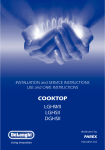Download Fisher & Paykel CG604DX User's Manual
Transcript
Gas cooktop User guide CG604DX & CG905DX models NZ AU Contents Safety and warnings Introduction Using your cooktop Cooking guidelines and cookware Care and cleaning Troubleshooting Warranty and service Important! SAVE THESE INSTRUCTIONS The models shown in this document may not be available in all markets and are subject to change at any time. For current details about model and specification availability in your country, please visit our local website listed on the back cover or contact your local Fisher & Paykel dealer. 1 2 5 6 8 9 13 16 2 Safety and warnings Operation WARNING! Poisoning Hazard Never use this appliance as a space heater to heat or warm the room. Doing so may result in carbon monoxide poisoning and overheating of the appliance. Failure to follow this advice may result in poisoning or death. WARNING! Hot Surface Hazard This appliance becomes hot during use. Do not touch the cooktop components, burners, pan supports or the stainless steel surfaces when hot. Before cleaning, turn the burners off and make sure the whole cooktop is cool. Failure to follow this advice may result in serious injury. WARNING! Fire Hazard Never leave the appliance unattended when in use. Boilover causes smoking and greasy spillovers that may ignite. Failure to follow this advice may result in serious injury. WARNING! Explosion Hazard Do not use or store flammable materials such as gasoline near this appliance. Do not spray aerosols in the vicinity of this appliance while it is in operation. Failure to follow this advice may result in death or serious injury. WARNING! Electrical Shock Hazard Switch the power to the cooktop off at the wall before cleaning or maintenance. Failure to follow this advice may result in death or electrical shock. Safety and warnings 3 Important safety instructions! Operation Keep children away from the cooktop when it is in use. Household appliances are not intended to be played with by children. Children, or persons with a disability which limits their ability to use the appliance, should have a responsible person to instruct them in its use. The instructor should be satisfied that they can use the appliance without danger to themselves or their surroundings. If the electrical supply cord is damaged, it must only be replaced by an authorised person. If the appliance is connected to the gas supply with a flexible hose, make sure that the hose cannot come in contact with the bottom of the appliance or any sharp edges. Ensure that the electrical connection plug is accessible after installation. This appliance should be connected to a circuit that incorporates an isolating switch providing full disconnection from the electricity supply. Do not use an asbestos mat or decorative covers between the flame and the saucepan as this may cause serious damage to your cooktop. Do not place aluminium foil or plastic dishes on the cooktop burners. Do not let large saucepans, frying pans or woks push any other pans aside. This could make them unstable or deflect heat onto your benchtop and damage the surface. Do not use a steam cleaner for cleaning this cooktop. Saucepan handles may be hot to touch. Ensure saucepan handles do not overhang other gas burners that are on. Keep handles out of reach of children. Do not stand or place heavy objects on this appliance. After use, ensure that the control dials are in the ‘OFF’ (o) position. Where this appliance is installed in marine craft or in caravans, it shall not be used as a space heater. The use of a gas cooking appliance results in the production of heat and moisture in the room in which it is installed. Ensure the kitchen is well ventilated. Keep natural ventilation holes open or install a mechanical ventilation device (mechanical extractor hood). Prolonged intensive use of the appliance may call for additional ventilation, for example opening of a window, or more effective ventilation, for example increasing the level of mechanical ventilation where present. After having unpacked the appliance, check to ensure that it is not damaged. In case of doubt, do not use it and consult your supplier or a professionally qualified technician. Packing elements (eg plastic bags, polystyrene foam, nails, packing straps, etc.) should not be left around within easy reach of children, as these may cause serious injuries. Do not modify this appliance. This appliance is to be serviced only by an authorised person. Some products are supplied with protective film on steel and aluminium parts. This film must be removed before using the appliance. Introduction 5 About your new cooktop Thank you for buying a Fisher & Paykel gas cooktop. We recommend you read the whole guide before using your new cooktop, for both safety and cooking success. For more information, visit our local website listed on the back cover. Safety feature: flame failure protection Your cooktop is equipped with flame failure protection: the gas supply will automatically be cut off to a burner that is accidentally blown out by a draught or extinguished by a spill. Before using the cooktop for the first time Read this user guide, taking special notice of the ‘Safety and Warnings’ section. Check that the pan supports are all in place and stable, and the flame spreaders, burner caps and rings are all seated correctly. Check that the installer has completed the ‘Final checklist’ in the Installation instructions. Ensure the power supply to the cooktop is turned on. 1 1 3 5 1 2 3 4 5 6 6 Cooktop layout - CG604DX 1 1 4 2 5 6 Cooktop layout - CG905DX Semi-rapid burner Rapid burner Mini wok burner Wok burner Auxiliary burner Control dials Using your cooktop 6 Off b a High High Low Burner indicator 1 Identify the dial of the burner you want to use. a 2 Press down (a) then turn anti‐clockwise to High (b). The ignitors will start clicking as they spark. If there is no clicking, there is no spark to light the burner. If the burner fails to light turn the dial back to off (o) and see ‘Troubleshooting’. 4 When you have finished cooking, turn the dial clockwise back to off (o). Check that the burner has gone out. Before leaving the kitchen, check that all burners have been turned off. 3 secs b High Low 3 After the burner has lit, keep the dial held down for 3 more seconds (a), then release. You may now adjust the flame anywhere between High and Low (b). Do not adjust or leave the dial between High and off (o). Important! Turn the burner off (o) and see ‘Troubleshooting’ for what to do next if you experience any of the following: There’s a strong gas smell. The flame has been blown out by a draught or extinguished by a spill. There is no clicking/sparking or there is clicking/ sparking, but a burner or burners won’t light. The flames don’t burn all the way around a burner, or some flames flicker. The flame goes out when you release the dial 3 seconds after lighting. The flame is yellow or yellow‐tipped rather than blue. The flames are too large, small, irregular, noisy or lift away from the burner. Using your cooktop 7 Wok cooking Use your wok only on the wok or mini wok burner (depending on model) and with the supplied wok stand in place, as shown. Important! Make sure that the wok stand is stable: its notches need to fit tightly over the pan supports, as shown. Make sure the wok does not push any other pans aside. This could make them unstable, or deflect heat onto nearby walls or the benchtop. Notch CG905DX Wok burner illustrated 8 Cooking guidelines and cookware Cooking guidelines Important! Never leave the cooktop unattended when in use. Boilover causes smoking and greasy spills that may ignite. Take care when deep-frying: oil or fat can overheat very quickly, particularly on a high setting. Using a lid will reduce cooking times through retaining the heat. Minimise the amount of liquid to reduce cooking times. Cookware Use saucepans with thick flat bases. Do not let large saucepans or frying pans overlap the bench, as this can deflect heat onto your benchtop and damage its surface. Always make sure saucepans are stable by centring them over the burner. Make sure the size of the pan matches the size of the burner. A small pot on a large burner is not efficient.The following table shows the minimum and maximum saucepan base diameters that may be used on each burner: Burner Minimum ∅ Maximum ∅ Auxiliary n/a 22 cm Semi-rapid n/a 22 cm Rapid n/a 22 cm 15 cm 22 cm n/a 36 cm 20 cm 40 cm n/a 45 cm Mini wok regular pans woks (with wok stand) Wok regular pans woks (with wok stand) Care and cleaning 9 Important! Before any cleaning or maintenance, always: turn all burners off. switch the power to the cooktop off at the wall. make sure that the cooktop and its parts are a safe temperature to touch. General advice Clean the cooktop regularly—do not let stains become burnt on, as they may become very difficult to remove. Do not use abrasive cleaners, cloths or pads to clean any part of your cooktop. Some nylon scourers may also scratch. Check the label. Clean up spillages as soon as possible. If left to dry on, food residue may clog the flame ports, causing an uneven flame pattern. Make sure that no cleaner residue is left on any cooktop part; when heated, these could stain the cooktop. See the following pages for instructions on replacing the pan supports and reassembling the burners correctly after cleaning. Do not clean cooktop parts in a self-cleaning oven. Do not use a steam cleaner. What? How often? Stainless steel base After every use 1 2 3 4 5 Control dials As needed 1 2 How? Important! Soak any stubborn stains under a hot soapy cloth. Wipe the soiling off with a cloth using a mild household detergent or stainless steel cleaner. Wipe with a clean damp cloth. Wipe the surface dry with a microfibre cloth. For extra shine, use a suitable stainless steel polish. Hard water spots can be removed with household white vinegar. Do not use abrasive cleaners, steel soap pads or sharp objects on stainless steel. Always read the label to make sure that your stainless steel cleaner does not contain chlorine compounds as these are corrosive and may damage the appearance of your cooktop. Always rub the stainless steel in the direction of the grain. The graphics are etched onto the steel by laser and will not rub off. Wipe with a damp cloth and mild detergent. Stainless steel cleaner can be used on the top surface of the dials only. Dry thoroughly with a soft cloth. Do not use oven cleaner on the dials, as doing so may damage their coating. 10 Care and cleaning What? How often? Burner caps and rings, flame spreaders, pan supports, wok stand As needed, but at least once a month 1 2 3 How? Important! Remove the parts that you wish to clean. See the the illustrations following this chart. Soak stubborn stains in a solution of biological clothes washing detergent or powdered dishwasher detergent. Clean the parts in hot soapy water. Use a stiff nylon brush or straight-ended paper clip to clear the flame ports. Make sure you keep the flame ports clear. Soiling from food spillage may clog these and cause ignition problems or uneven flame patterns. Remove stains left by food or spillovers as soon as possible. If left to burn on, they may be difficult to remove or even permanently discolour these parts. Before replacing the burner parts, make sure that they are completely dry. Wet burner parts may result in an irregular flame. Before lighting a burner you have reassembled, check that all of its parts have been positioned correctly. Incorrect assembly can cause dangerous irregular flames and ignition problems. Flame ports (mini wok burner only) 4 5 6 Ignitor and probe At least once a month Rinse in warm water. Dry thoroughly. Replace the parts correctly, as shown in the drawings following this chart. These parts are also dishwasher safe. Clean these very carefully using a toothbrush dipped into methylated spirits. Ignitor All gas components of the cooktop Once every 3-4 years Flame ports Probe Contact your local Authorised Repairer to perform a thorough check on all gas components of the cooktop. For Authorised Repairer details, see your Service & warranty book or contact Customer Care. A clean ignitor ensures trouble-free sparking and the probe ensures that the flame failure protection operates. Check the ignitor and probe regularly to make sure they are clean. All checking and maintenance must be performed by a suitably qualified person. If the gas is connected with a flexible hose, checking should include inspecting the entire length of the flexible hose assembly for any sign of wear or damage. Care and cleaning 11 Replacing the pan supports correctly CG905DX models The wok support goes in the centre, over the wok burner. The two side pan supports are interchangeable but need to be rotated so the rounded corners are to the outside, matching the cooktop base. Fig.19 Correct positioning of pan supports (CG905DX models) CG604DX models The pan supports can only be placed as shown and need to be rotated to match the rounded corners of the cooktop base and the opening fits over the mini-wok burner. Fig.20 Correct positioning of pan supports (CG604DX models) 12 Care and cleaning Replacing the burner parts correctly Semi-rapid, rapid, and auxiliary burners Cap Flame spreader Probe Ignitor Wok and mini wok burners (Wok burner illustrated) Flame spreader Ignitor Cap Ring Probe Troubleshooting Problem There is a strong gas smell. 13 Possible causes and solutions The gas connection could be leaking because of incorrect installation or damaged piping. Important! Do not use any electrical equipment or operate any electrical switches. 1 If any burners are on, turn all of them off immediately. 2 If you know how to shut off the gas supply to your cooktop (either at the valve or the gas bottle), do so. 3 Open a window to let the gas out. 4 Contact your local Authorised Repairer as soon as possible. Important! Do not use the cooktop until it has been repaired. There is a slight rubbery or metallic smell when I use the cooktop for the first time. This is normal for first use and is caused by manufacturing residues burning off. The smell will disappear with use. There is a power failure. You can still use your cooktop, but will need to match‐light the burner(s). To do so, press down and turn the dial anticlockwise to High while holding a lighted match close to the side of the burner. Keep the dial held down for 3 seconds after the burner has lit, then release. Wait until the flame is burning evenly before adjusting it. There is no clicking/ sparking. There is a power failure. See entry ‘There is a power failure’ above. The ignitor(s) may be dirty or wet. Clean them following the instructions in ‘Care and cleaning’. There is clicking/ sparking, but a burner or burners won’t light easily or at all. Wait 1 minute, then try to relighting the burner again, holding the dial for a few more seconds this time around. If this doesn’t work and the burner still won’t light, see the other possible causes and solutions below. The gas supply may not be turned on at the valve or gas bottle. Turn all the burners off, and check whether the gas supply to the cooktop is turned on. The gas supply to the house may not be working. You should hear the gas when you turn a burner on. If you use bottled gas, this may indicate you are getting near the end of the bottle and need to replace it. Burner parts may be clogged or wet. Make sure that they are clean and dry. See ‘Care and cleaning’ for instructions. Burner parts may not have been replaced correctly. Check the assembly and make sure the burner cap is sitting flat. See ‘Care and cleaning’ for illustrations. 14 Troubleshooting Problem The burner goes out when I release the dial 3 seconds after the flame lighting. Possible causes and solutions Try lighting the burner again, this time holding the dial down longer. The flame has been blown out by a draught or extinguished by a spill. The flame failure protection will automatically cut the gas supply to the burner off, stopping unburnt gas from escaping. Turn the affected burner off, then wait for at least 1 minute before attempting to relight. This is to allow for any small amount of gas that may have escaped to disperse. The flame goes out at low settings. The gas supply pressure may be low. Check this with your service person or installer. If you use bottled gas, this may indicate you are getting near the end of the bottle The flames are yellow or yellow‐tipped rather than blue. Burner parts (especially the flame ports) may be clogged or wet. Check that they are clean and dry. The flame pattern is uneven around the burner. Burner parts (especially the flame ports) may be clogged or wet. Check that they are clean and dry. See ‘Care and cleaning’ for instructions and illustrations on clearing clogged flame ports. After cleaning, check that there is flame coming out of each port. The cooktop may have been connected to the wrong type of gas or the gas pressure is not correct. Contact Customer Care and do not use your cooktop until it has been checked by a qualified technician. Flame ports (mini wok burner only) Flame ports Burner parts may not have been replaced correctly. Check the assembly and make sure the burner cap and/or ring is sitting flat on the flame spreader. See ‘Care and cleaning’ for illustrations. Burner cap Flame spreader Troubleshooting Problem The flames are too large, or too small. The flames are noisy. The flames lift away from the burner. Possible causes and solutions The cooktop may have been connected to the wrong type of gas. Contact Customer Care and do not use your cooktop until it has been checked by a qualified technician. 15 16 Warranty and service Before you call for service or assistance ... Check the things you can do yourself. Refer to the installation instructions and your user guide and check that: 1 2 Your product is correctly installed. You are familiar with its normal operation. If after checking these points you still need assistance or parts, please refer to the Service & Warranty book for warranty details and your nearest Authorised Repairers, Customer Care, or contact us through our local website listed on the back cover. This cooktop has been designed and constructed in accordance with the following codes and specifications: In New Zealand and Australia: AGA101 (AS 4551) Approval Requirements for Domestic Gas cooking appliances AS/NZS 60335.1 General Requirements for Safety of household and similar electrical appliances AS/NZS 60335.2.102 Particular Requirements for gas, oil and solid-burning appliances having electrical connections AS/NZS CISPR 14.1. Electromagnetic Compatibility Requirements Fisher & Paykel Appliances Model no Serial no. Copy these from the serial label on the underside of the cooktop (right rear) or from the duplicate data label. Date of purchase Contact details Dealer name www.fisherpaykel.co.nz www.fisherpaykel.com.au Copyright © Fisher & Paykel 2012. All rights reserved. The product specifications in this booklet apply to the specific products and models described at the date of issue. Under our policy of continuous product improvement, these specifications may change at any time. You should therefore check with your Dealer to ensure this booklet correctly describes the product currently available. NZ AU F&P PN - 590446 A 10.2012



































